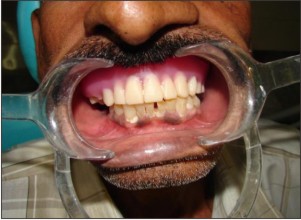Introduction
There are a number of drawbacks associated with full dentures, and not everyone can successfully wear them. In many instances, false teeth are not especially useful because of retention or stability problems. For this reason, even a single healthy tooth left in place can stabilize an otherwise unstable full denture. Only recently has it become possible to build a denture leaving a hole here and there to allow a few remaining teeth to poke through without ruining the suction, which generally holds the denture in the mouth.
Cusil Denture
The Cu-Sil denture has holes for natural teeth. These holes are surrounded by a gasket of stable silicone rubber. CuSil dentures are not the best solution for people with numerous, evenly distributed, stable natural teeth. They are advertised mostly as "transitional" dentures.
Indications for the Cu-Sil Overdenture
1. Any patient with mobile, isolated or periodontally involved teeth whose last resort appears to be an immediate full denture.
2. A patient who does not want to lose his remaining teeth but cannot be adequately treated with fixed or other removable partial dentures is a Cu-Sil denture candidate.
3. A patient with a few remaining teeth whose mucosa, supporting bone, or general health, suggests a poor prognosis for complete dentures.
4. When natural maxillary teeth are to oppose a mandibular complete denture.
Advantages of Cu-Sil Overdentures
1. There is less time, effort and precision required in chairside and laboratory procedures. No special tooth preps or impression techniques are required.
2. Cu-Sil cases require no adjustments upon insertion and no post-insertion adjustments. Comfort is quickly and easily achieved upon seating, since tissues and acrylic tissue bearing Cu-Sil partials adapt to each other more readily.
3. Vertical dimension and original bite is automatically maintained.
4. The Cu-Sil denture is more affordable since endodontic therapy is not needed. Extraction costs are also reduced.
5. Previous bone loss is rejuvenated. Tissue response is remarkable. Denture stability and retention is achieved even is only one or two teeth are retained.
6. Propriosensitivity is maintained, potential psychological impact is avoided, and less trauma is realized when patient is not rendered totally edentulous.
7. Cu-Sil partial dentures eliminate clasps and preserve dentition. They stabilize, cushion and splint teeth with an elastomeric gasket that provides retention and seals out food. Stops trauma, stress and wear to teeth caused by torque-inducing metal partials.
8. A CuSil denture can stabilize loose teeth and, with care, can extend their lives. It is also easy to replace lost natural teeth on the CuSil denture.
Case Report
Name : Dilli Bhasker
Age : 53
Sex : Male
Chief complaint : Patient complains of bad taste and smell from upper front tooth region
Personal history : Patient is a chronic smoker for the past 20 years almost 10 cig/day
 |
 |
Treatment
1. Primary impression was made with alginate and special tray was fabricated by blocking the area where the teeth were present.
2. Border molding was done and final impression was taken.
3. Jaw relations were recorded and articulation, teeth arrangement was done.
4. Finally trial and final processing was done.
 | Before
 |
 | After
 |
References
1. Walter J D. A study of partial denture design produced by an alumni group of dentists in health service practice. Eur J Prosthodont Rest Dent 1995; 3: 135–139.
2. Boucher’s Prosthodontic Treatment for Edentulous Patients. 9th ed. St. Louis, MO
3. Carlsson GE. Clinical morbidity and sequelae of treatment with complete dentures. J Prosthet Dent. 1998;79(1):17-23.
4. Norling BK, Reisbick MH. The effect of nonionic surfactants on bubble entrapment in elastomeric impression material. J Prosthet Dent. 1979;42(3):324-347.
5. Smith S, Heffler S, Freeland M. The next decade of health spending: a new outlook. Health Aff (Millwood) 1999;18(4):86–95.
|